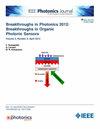Self-Correction in Free-Running Dual-Comb Spectroscopy With Varying Interferogram Refresh Rates
IF 2.1
4区 工程技术
Q3 ENGINEERING, ELECTRICAL & ELECTRONIC
引用次数: 0
Abstract
The dual-comb spectrometer has emerged as a preferred instrument in multiheterodyne spectroscopy due to its high-resolution and fast-scanning capabilities. Conventional dual-comb spectroscopy (DCS) requires locking or reference systems, increasing both system complexity and cost, and limiting its commercial feasibility. Self-correction offers a promising alternative, though it demands a high refresh rate for interferograms (IGMs), corresponding to the repetition frequency difference, to counter system noise. This study examined the practical effects of self-correction at various refresh rates by measuring随干涉图刷新率变化的自由运行双梳光谱的自校正
由于其高分辨率和快速扫描能力,双梳光谱仪已成为多外差光谱的首选仪器。传统的双梳光谱(DCS)需要锁定或参考系统,增加了系统的复杂性和成本,限制了其商业可行性。自校正提供了一个很有前途的替代方案,尽管它需要干涉图(igm)的高刷新率,对应于重复频率差,以对抗系统噪声。本研究通过测量$\rm H^{13}C^{14}N$吸收率,考察了在不同刷新率下自校正的实际效果。结果表明,较高的重复频率差提高了自校正性能,而较低的重复频率差会导致吸收线宽度和强度的偏差。实际应用中必须平衡测量带宽,而测量带宽受重复频率差的限制。
本文章由计算机程序翻译,如有差异,请以英文原文为准。
求助全文
约1分钟内获得全文
求助全文
来源期刊

IEEE Photonics Journal
ENGINEERING, ELECTRICAL & ELECTRONIC-OPTICS
CiteScore
4.50
自引率
8.30%
发文量
489
审稿时长
1.4 months
期刊介绍:
Breakthroughs in the generation of light and in its control and utilization have given rise to the field of Photonics, a rapidly expanding area of science and technology with major technological and economic impact. Photonics integrates quantum electronics and optics to accelerate progress in the generation of novel photon sources and in their utilization in emerging applications at the micro and nano scales spanning from the far-infrared/THz to the x-ray region of the electromagnetic spectrum. IEEE Photonics Journal is an online-only journal dedicated to the rapid disclosure of top-quality peer-reviewed research at the forefront of all areas of photonics. Contributions addressing issues ranging from fundamental understanding to emerging technologies and applications are within the scope of the Journal. The Journal includes topics in: Photon sources from far infrared to X-rays, Photonics materials and engineered photonic structures, Integrated optics and optoelectronic, Ultrafast, attosecond, high field and short wavelength photonics, Biophotonics, including DNA photonics, Nanophotonics, Magnetophotonics, Fundamentals of light propagation and interaction; nonlinear effects, Optical data storage, Fiber optics and optical communications devices, systems, and technologies, Micro Opto Electro Mechanical Systems (MOEMS), Microwave photonics, Optical Sensors.
 求助内容:
求助内容: 应助结果提醒方式:
应助结果提醒方式:


